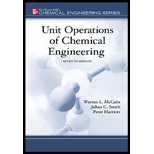
(a)
Interpretation:
The maximum flow rate through a fire hose for a pump is to be determined.
Concept Introduction:
The flow rate through the fire hose is given as,
The notations used here are,
D = Diameter of the fire hose
The average velocity can be calculated from the pressure drop of the fluid,
The notations used here are,
g = Acceleration due to gravity
f = Fanning friction factor
L = Length of the duct
The Reynolds number is given as,
The notations used here are,
D = Diameter of duct
The roughness parameter is given as,
(b)
Interpretation:
The increase in flow is to be determined due to contamination by ethylene oxide.
Concept Introduction:
The change in friction factor determines the change in flow rate as it depends on the average velocity keeping other factors constant.
Thus,
The flow rate through the fire hose is given as,
The notations used here are,
D = Diameter of the fire hose
The average velocity can be calculated from the pressure drop of the fluid,
The notations used here are,
g = Acceleration due to gravity
f = Fanning friction factor
L = Length of the duct
Combining equation (1) and (2), it can be deduced that,
Want to see the full answer?
Check out a sample textbook solution
Chapter 5 Solutions
Unit Operations of Chemical Engineering
 Introduction to Chemical Engineering Thermodynami...Chemical EngineeringISBN:9781259696527Author:J.M. Smith Termodinamica en ingenieria quimica, Hendrick C Van Ness, Michael Abbott, Mark SwihartPublisher:McGraw-Hill Education
Introduction to Chemical Engineering Thermodynami...Chemical EngineeringISBN:9781259696527Author:J.M. Smith Termodinamica en ingenieria quimica, Hendrick C Van Ness, Michael Abbott, Mark SwihartPublisher:McGraw-Hill Education Elementary Principles of Chemical Processes, Bind...Chemical EngineeringISBN:9781118431221Author:Richard M. Felder, Ronald W. Rousseau, Lisa G. BullardPublisher:WILEY
Elementary Principles of Chemical Processes, Bind...Chemical EngineeringISBN:9781118431221Author:Richard M. Felder, Ronald W. Rousseau, Lisa G. BullardPublisher:WILEY Elements of Chemical Reaction Engineering (5th Ed...Chemical EngineeringISBN:9780133887518Author:H. Scott FoglerPublisher:Prentice Hall
Elements of Chemical Reaction Engineering (5th Ed...Chemical EngineeringISBN:9780133887518Author:H. Scott FoglerPublisher:Prentice Hall
 Industrial Plastics: Theory and ApplicationsChemical EngineeringISBN:9781285061238Author:Lokensgard, ErikPublisher:Delmar Cengage Learning
Industrial Plastics: Theory and ApplicationsChemical EngineeringISBN:9781285061238Author:Lokensgard, ErikPublisher:Delmar Cengage Learning Unit Operations of Chemical EngineeringChemical EngineeringISBN:9780072848236Author:Warren McCabe, Julian C. Smith, Peter HarriottPublisher:McGraw-Hill Companies, The
Unit Operations of Chemical EngineeringChemical EngineeringISBN:9780072848236Author:Warren McCabe, Julian C. Smith, Peter HarriottPublisher:McGraw-Hill Companies, The





